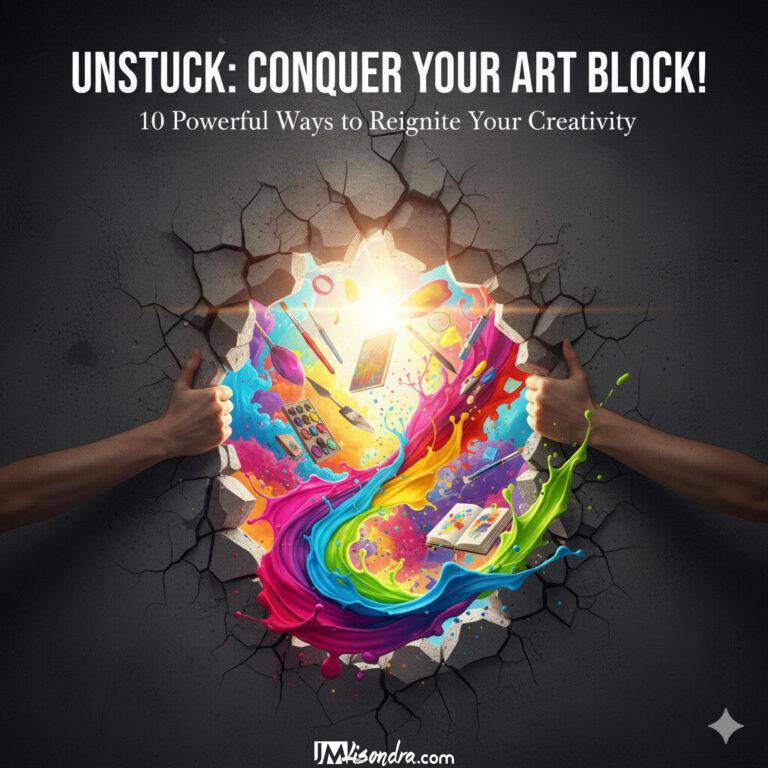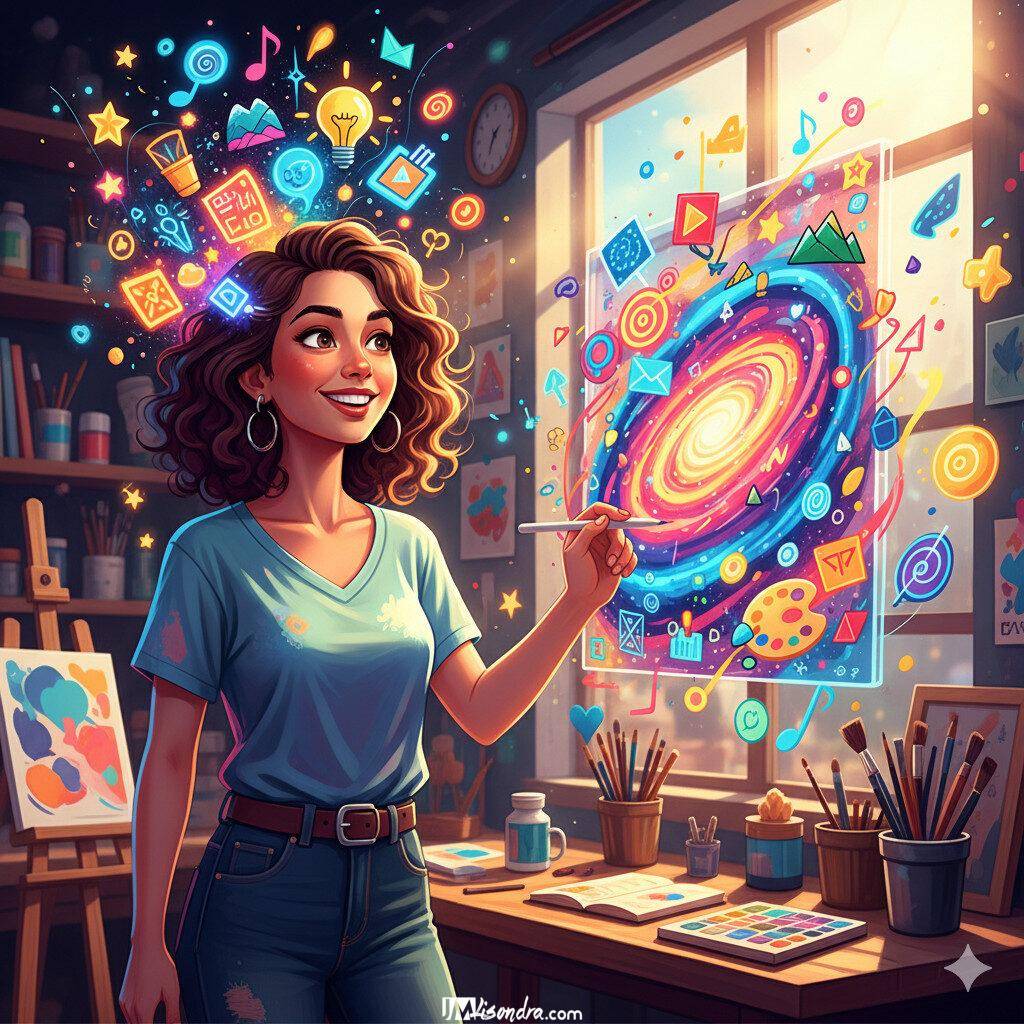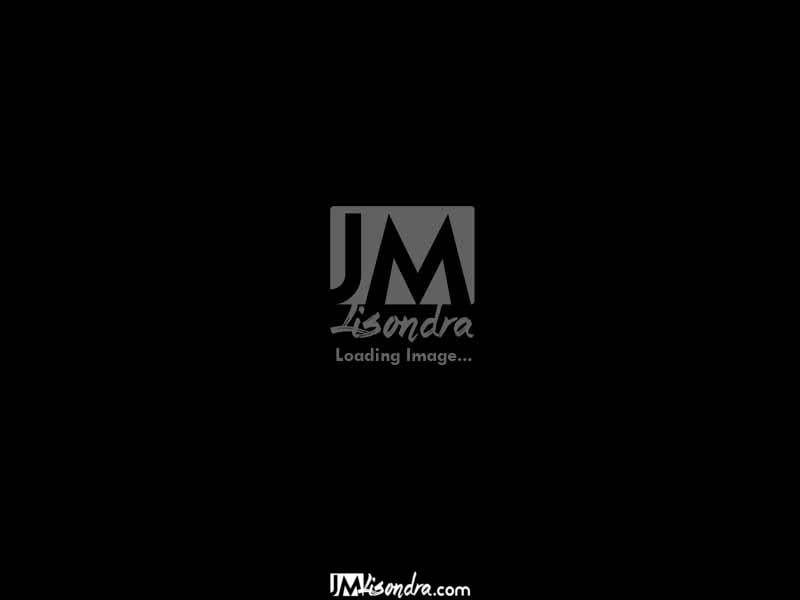Unstuck: 10 Powerful Ways to Conquer Your Art Block TODAY

The blank canvas glares back at you. Your sketchbook is untouched. The desire to create is there, but the inspiration—or the will to start—has evaporated. If you are an artist, you know this frustrating, often disheartening experience: the infamous Art Block.
It’s more than just a temporary lack of ideas; it’s a creative standstill that can make you question your passion and your talent. But here’s the crucial truth: Art block is a normal, even necessary, part of the creative cycle.1 It’s your brain signaling that it’s time to rest, change course, or refill your creative well.
You don’t have to wait for inspiration to strike. You can actively invite it back. In this comprehensive guide, we'll explore 10 powerful, practical, and proven strategies to help you break through your creative slump, reignite your passion, and get your brushes (or pens, or stylus) moving again.
1. Diagnose the Root Cause of Art Block: Is it Fear or Fatigue?
Before you can fix the problem, you need to understand it. Art block often falls into one of two main categories:
A. Fear-Based Block (The Inner Critic)
This block is driven by perfectionism, fear of failure, or comparison to others. Your inner critic whispers: "This won't be good enough," "You're just copying," or "Why bother?" This pressure paralyzes you before you even start.
B. Fatigue-Based Block (The Empty Well)
This block stems from burnout, exhaustion, or a lack of new input. You've pushed yourself too hard, worked on the same project for too long, or haven't taken the time to experience life outside your studio. Your creative well is simply dry.
The Solution: Pinpoint which type of block you have. If it’s Fear, focus on process over product (Strategy #2). If it’s Fatigue, focus on rest and new experiences (Strategy #4 & #8).
2. Embrace the 'Shitty First Draft' Mentality
The pursuit of perfection is the fastest way to stay blocked. When facing a creative slump, your primary goal is not to create a masterpiece, but simply to move your hand.
- The 10-Minute Rule: Commit to drawing, sketching, or painting for only ten minutes. Tell yourself it must be terrible. The pressure is off! You can always stop after ten minutes, but more often than not, the act of starting generates momentum.
- Process Over Product: Create art specifically for the trash bin. Use cheap materials, a new medium (like pastels or charcoal), or the back of an old painting. By removing the pressure of an "end result," you free your mind to play.
Internal Link Idea: If you’re stuck on technique, sometimes reviewing the fundamentals helps. Check out our Beginner Acrylic Painting Tutorials to try a simple exercise like color mixing or basic blending.
3. The Power of Constraints: Give Yourself a Simple Prompt
A blank page is overwhelming because the possibilities are infinite. Creativity often thrives when you introduce constraints. Give yourself a simple, small, and specific task.
| Constraint Type | Example Prompt | Why it Works |
| Time | Draw a still life of an apple in 60 seconds. Repeat 10 times. | Focuses on speed and gesture, not detail. |
| Color | Create a painting using only two colors (e.g., Ultramarine Blue and Cadmium Yellow) plus white. | Challenges you to focus on value and mixing. |
| Material | Use only a ballpoint pen and a single sheet of office paper. | Removes the pressure of expensive supplies. |
| Subject | Sketch 10 different versions of a household item (a shoe, a coffee mug). | Forces you to observe and experiment with form. |
4. Change Your Environment, Change Your Perspective
Sometimes, the block is less about your ideas and more about your surroundings.2 Your studio is a place of work—try making art in a place of play.
- Go Outdoors: If you're a landscape painter, take your small sketchbook and sit outside. Sketch a Big Tree in Acrylics but focus only on the main shape and lighting. Even a five-minute sketch can refresh your vision.
- Visit a Museum/Gallery: Step away from your desk and immerse yourself in art history. Seeing masterpieces in person can be incredibly humbling and inspiring, reminding you of the vast possibilities of creation.
- The Café Challenge: Go to a public place, order a drink, and sketch the people and objects around you. Sketching from life is a mechanical exercise that gets the creative gears turning without demanding emotional investment.
5. Switch Mediums or Subjects Completely
Your brain needs novelty. If you've been working on detailed portraits for months, switch to abstract expressionism. If you're a meticulous oil painter, try the fast, fluid nature of acrylics or watercolor.
- Acrylics for Change: Acrylics, with their quick-drying nature, are perfect for breaking a block because you can't overthink a stroke. Try a quick, loose Palette Knife Painting to embrace texture and abandon detail.
- Digital Detox: If you mostly work digitally, put the tablet down and pick up charcoal or clay. The physical, tactile experience of traditional media can re-engage your senses.
6. The Copywork Method (Master Studies)
There is a long, respected tradition in art of learning by copying the masters. This is not about plagiarism; it's about education.
- Why it Works: Copying a master's painting or drawing allows you to practice fundamentals (composition, color theory, value) without the pressure of having an original idea. It turns the task into a technical problem to solve, not a creative one.
- Focus on Elements: Don't try to copy the whole thing. Focus on one aspect: the way a master painted a cloud, the color palette they used for a shadow, or the brushstrokes in their foreground.
7. Refill the Well: Get Input (That Isn't Art)
Creative output requires creative input. If you're blocked, it's often because your well is empty. Stop looking at art for inspiration and start looking at life.
- Read: Dive into a genre of fiction or non-fiction you’ve never tried.
- Listen: Explore a new genre of music, a thought-provoking podcast, or a detailed audiobook.
- Watch: Find a documentary about an unrelated subject (science, history, nature) or watch one of the Top Must-Watch Movies For Visual Artists.
- Move: Exercise, go for a long walk, or even just clean your house. Physical activity gets the blood flowing, and a clean workspace can clear your mind.
8. Prioritize Self-Care and Rest
Burnout is a major cause of art block. Creativity cannot flourish in a state of exhaustion.
- Take a True Break: Give yourself permission to not create for 3 to 7 days. Do not touch your art supplies. If you find an idea striking you, simply write it down in a dedicated "Idea Jar" and promise to return to it later.
- The Art of Sleep: Studies show that sleep is essential for consolidating memories and connecting disparate ideas—the very mechanism of creativity. Prioritize 7-9 hours of quality sleep to allow your brain to process and organize your inspiration.
9. Connect with the Creative Community
Sometimes, a creative block feels isolating, but it’s a universal experience for artists. Reaching out can provide both practical tips and much-needed emotional support.
- Join a Group: Find a local or online art group. Even simple conversation can spark an idea.
- Teach a Beginner: The act of simplifying and explaining a technique to someone new often makes you realize how much you already know, boosting your confidence. You can always share your tips and journey by learning How to Become an Art Content Creator.
External Resource: For real-time, peer-to-peer support, join a community. The r/ArtistLounge subreddit is a supportive online community where artists frequently share their struggles with art block and offer helpful, practical advice.
10. Start a 'Ugly' Sketchbook
Get a cheap notebook and dedicate it as your "No-Judgment Zone." The goal of this sketchbook is to be filled with the worst, ugliest, most nonsensical drawings possible.
- Doodle with Intent: Instead of a finished piece, dedicate pages to exercises: drawing simple shapes, quick Basic Color Mixing swatches, or writing down ridiculous ideas.
- The Freedom of Failure: By labeling the sketchbook as "ugly," you are giving yourself unconditional permission to fail. This is the ultimate tool for silencing the inner critic and allowing your instinct to take over.
Final Thoughts: The Block is the Lesson
Art block is not a sign of failure; it’s a sign that you need to shift gears. It's a natural ebb in the creative flow. By using these practical strategies, you are not waiting for inspiration—you are creating the conditions for it to return.
Stop pressuring yourself to create a masterpiece. Start by simply making a mark. The next best piece you create will be on the other side of this block.
Would you like a list of 5 simple, one-hour creative prompts tailored for painters to help you implement strategy #3 (Constraints)?






